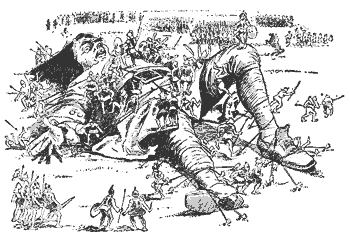Gen. Stanley McChrystal (center) explains U.S. strategy
in Afghanistan at a news conference.
As a neo-Marxist in good standing, President for Life Obama should be well aware of the original Marxist's quip, "History repeats itself, first as tragedy, second as farce." The news from the Comeback War, the one in Afghanistan, proves it yet again. Or maybe if it's historical precedent we're grasping for, think of Nietzsche's theory of the eternal return: "In an infinite universe, with no god to direct it, the finite experiences of human existence must necessarily repeat themselves eternally."
It's Hearts and Minds time again. Back to the first reel. This is where I came in. And hard-won common sense about the nature of war went out. The U.S.military has issued new guidelines, delivered via farcical item A, its social networking page: U.S. Gen. Stanley McChrystal, who took over last month as the commander of U.S. and NATO forces, has said he wants his troops' first priority to be protecting Afghan civilians [farcical item B], not using massive fire power. McChrystal's new guidelines went into effect last week, and officials released a declassified version Monday.
The three directives for U.S. and NATO forces, posted on the military's Facebook page as part of a longer statement, are [farcical items C, D, and E]:
_ Airstrikes must be very limited and authorized but can be used in self-defense if troops' lives are at risk.
_ Troops must be accompanied by Afghan forces before they enter residences.
_ Troops cannot go into or fire upon mosques or other religious sites. This is already U.S. policy.
The new CEO of the Taliban, whoever he is, must be laughing till tears flow. The world's military giant not waiting for the Lilliputians to tie it down, but doing the job itself.

If these directives are followed, it means:
Air power, often the most effective and least casualty-prone offensive tactic, may be used only in self-defense "if troops' lives are at risk." Far be it from me to claim any military expertise, but my impression is that in combat hot zones, troops' lives are always at risk.
So, hold back the air power. Perhaps each ground soldier could select one carefully researched and certified enemy combatant and call him out. Pistols at dawn? No, unfair. U.S. pistols are better made. Swords then, in single combat.

The Taliban is shooting at you from the pool deck of a house? Quick, ring for an Afghan with a search warrant. No, not an Afghan hound — not even to sniff out booby trap bombs, don't you know dogs are an abomination to Muslims? And wipe your feet before you enter, you oaf.

You need not notify the enemy commander that the ammunition depot and safe house inside the holy mosque is sacred. To you, if not to him. He has already been informed.
U.S. Gen. Stanley McChrystal, who took over last month as the commander of U.S. and NATO forces, has said he wants his troops' first priority to be protecting Afghan civilians, not using massive fire power.
Begging your pardon, mon général, but in a war — if that's what this Afghanistan sort-of what-do-you-call-it is — the first priority is to destroy the enemy. There are historical examples in which that required "massive firepower," incidentally. The second priority is protecting the poor sods under your command. Not killing Afghan civilians, assuming you can tell which civilians are the civil type and which are the insurgent type, is a nice idea. But it is not of the essence.
Except to President for Life Obama, who sees military action as a form of community organizing. Our country's commander-in-chief, like the commander-in-chief before him, likes playing toy soldiers. The problem is that those toy soldiers bleed and break and their hearts can be stopped.

For that reason, if no other, some of us have the idea that they should only be used in the most urgent defense of national interests. Not just any national interests, such as community outreach to Afghan tribes.
If making friends with Afghans is our priority, let's bring the service men and women home to their families and send a stimulus package in their place. Let's give every Afghan (unless found by a court to have committed assault and battery in the Taliban or Al Qaeda cause) a cheque for $100,000 and a brand new General Motors truck, with a five-year bumper-to-bumper warranty (except for acts of Allah) signed by Uncle Sam. The U.S. taxpayer would come out ahead and so would the Afghans. It's a win-win, I tell you.

"War is cruelty," General William Sherman famously said. "There is no use trying to reform it. The crueler it is, the sooner it will be over." If we do not believe the cause in Afghanistan, or Iraq, or anywhere else justifies the cruelty — and I am not arguing it does, being a little unclear what urgent national business detains us in Afghanistan after making our point seven years ago — then let's stop it. And no more American lives for social networking.

























